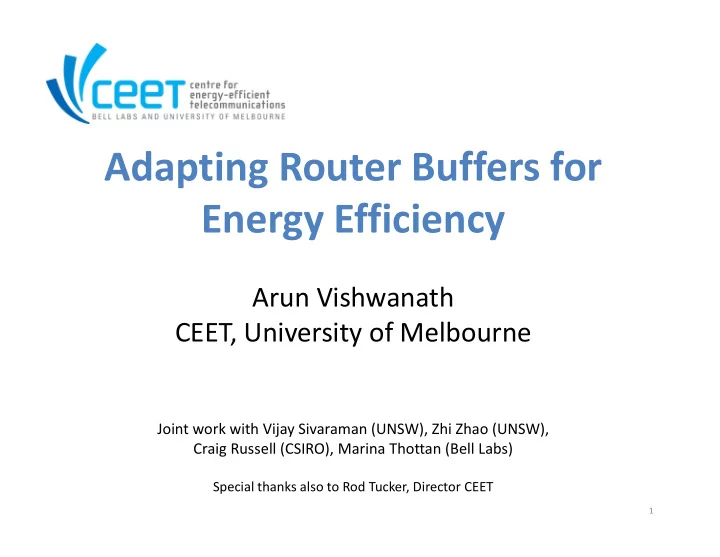

Adapting Router Buffers for Energy Efficiency Arun Vishwanath CEET, University of Melbourne Joint work with Vijay Sivaraman (UNSW), Zhi Zhao (UNSW), Craig Russell (CSIRO), Marina Thottan (Bell Labs) Special thanks also to Rod Tucker, Director CEET 1
Router Capacity Trends CRS-3 core router 446 W/line-card � Capacity 140 Gb/s � 12.3 KW/rack � 16 cards � 4.5 Tb/s (Total) � Year Courtesy: David Neilson, Bell Labs • Historically, router capacity x2 every 18 months – Future: Unlikely due to power density issues – Energy/bit falling 10% per year (3x per decade) – Traffic growing 40% per year (30x per decade) 2
Scaling Problem • With 10% per year power reduction and 40% per year traffic growth 2010 2020 100 Gb/s line-card 100 Gb/s line-card 3.2 Tb/s line-card 3.2 Tb/s line-card 400W 4000W • 30x increase in traffic from 2010 → 2020 – 20 Tb/s to 600 Tb/s – 12 racks – 768 KW just for the line-cards! 3
Ongoing Work • At network design stage – Optimise number of interfaces and chassis – Right combination of optical grooming and IP ports • Selectively turn-off/underclock line-cards • Redirect traffic to “greener” areas • Redirect traffic to “greener” areas • Promise high savings, however ... – Clean-slate approaches – Major architectural/protocol/design changes – Increases the barrier to adoption by ISPs 4
Our Objective • An evolutionary approach ... • Focus on packet buffer memory – Have large buffers at build time – But, adapt its size dynamically • Incentive – tangible energy savings Incentive – tangible energy savings – About 10% of line-card power consumption – Memory chips and controllers – 30 W × 16 line-cards × 50 routers = 24 KW → 2 core routers – Useful gains network-wide • ISPs become comfortable operating with small buffers – Pave the way for novel 2020 line-card designs 5
Talk Outline • Case for reducing buffering energy – Link loads – Buffer occupancy • Generic buffering architecture – Power saving mechanism – Energy model and algorithm • Performance evaluation – Simulations (with TCP) – Experimental validation (NetFPGA) • Conclusions 6
Link Loads in Operational Networks CCDF of link load: Major Tier-1 ISP CCDF of link load: Internet2 • Link load data spanning nearly 3 years • Congestion is a relatively infrequent event 7
Buffer Occupancy – Opportunity to Save Energy Load from Chicago-Kansas link Load from Chicago-Kansas link Buffer occupancy Buffer occupancy 5000 TCP flows 1000 TCP flows 8
Generic Model of Buffer Architecture Memory chips in parallel to meet throughput/latency requirements • Packet stored in off-chip memory straddles all chips • 9
Power Saving Mechanism • As buffer occupancy falls – Put to sleep DRAM row-3, then row-2, ... (~ 256 MB each) – Some point entire DRAM (controller + rows) is asleep – Occupancy falls further, put to sleep SRAM (~ 4 MB) – On-chip buffers (~ 100 KB) always-on • Conversely, as buffer occupancy grows Conversely, as buffer occupancy grows – Activate SRAM, then DRAM row-0, row-1, ... • Hysteresis protects against rapid toggling (sleep/awake) 10
Energy Model • DRAM – each row 256 MB – Power depends on frequency of read/write operations – Three states (for simplicity) • Active – high frequency of read/write (2W) • Idle – little or no read/write (200mW) • Sleep – read/write disabled (20mW) • Sleep – read/write disabled (20mW) • SRAM – one row 4 MB – Static component due to leakage current (dominates) • Proportional to the number of transistors – Two states – active 4W, sleep 40mW • Controller power ½ of entire memory 11
Algorithm • B I – amount of on-chip buffers • B S and B D – SRAM and DRAM buffer size • Q current buffer occupancy • Control parameter α [0,1) • Set buffer capacity B to be between Q and • Set buffer capacity B to be between Q and maximum available buffers, i.e., B = αQ + (1-α) (B I + B S + B D ) • α = 0 disables algorithm • Intentionally chosen a very simple scheme and have strived to have only one control knob 12
Evaluation – Internet2 Traffic Power versus loss trade-off • 10 min window of heavy load between Chicago and Kansas • Assume B I 16 KB, B S 80 KB, B D 512 KB • For α = 0.8, SRAM and DRAM on 2.66% and < 1% of the time • 95% of off-chip buffering energy saved • Packet loss 2 in about 100,000 13
ns2 Simulations with TCP 1 1 20 Dumbbell topology 1 2 0 1 20 Core 1Gbps algorithm on link 0-1 Edges 1 1Gbps 50 20 Access [100,300] Mbps 14
Performance of TCP (Reno) Flows • Mix of long-/short-lived flows, mean RTT 250ms • Simulation duration over 180s; results for α = 0.8 Workload Load Time off-chip Power Packet buffers used saved loss Low/Medium Low/Medium 21.5 - 41.1% 21.5 - 41.1% 0.25% 0.25% 97% 97% 0 0 10 -7 High 59.8% 12.3% 83.4% 10 -6 Heavy 78.6% 40% 52.9% Very Heavy 90.9% 82% 11.6% 10 -6 15
Demonstration using 1G NetFPGA card TCP traffic using Iperf UDP traffic burst • Validation of hardware implementation with UDP traffic burst • 150 TCP flows generated using Iperf – Algorithm reacts to buffer occupancy in real-time – 40% of off-chip buffering energy saved 16
Conclusions • Buffering consumes around 10% of the power • A very simple energy saving scheme – Only one control knob – Hardware changes minimal – No changes to network architecture/protocols – No changes to network architecture/protocols – Can be deployed in routers today • Large savings across hundreds of line-cards • Transition path to 2020 line-cards 17
NetFPGA Implementation http://netfpga.org/foswiki/bin/view/NetFPGA/OneGig/ RouterBufferAdaptation 18
Recommend
More recommend